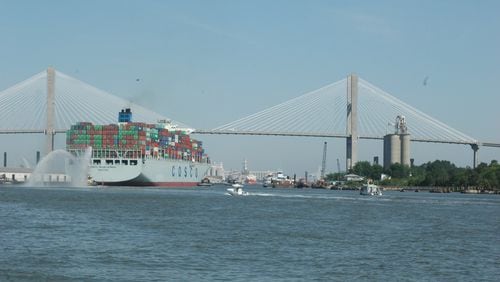SAVANNAH ― A frequently heard comment Monday night during the first public information session regarding a new Savannah River crossing to replace the Talmadge Bridge was “that’s a lot of money.”
Hours later, Georgia Ports Authority officials made it clear they don’t intend to be a funding source for either a new, higher bridge, projected to cost $1.17 billion, or a $2 billion beneath-the-river tunnel. In a Tuesday morning interview, CEO Griff Lynch and board Chairman Kent Fountain noted the ports paid $10 million for a feasibility study for the project but that construction of the new crossing and removal of the Talmadge Bridge was “outside their realm.”
Said Lynch, “I don’t think we have an appetite or an interest in going beyond” paying for the feasibility study.
The Ports Authority is behind the movement to replace the Talmadge Bridge. Lynch called for its removal in 2018, citing the span’s 185-foot height and the limitations posed to next-generation cargo ships needing to access port terminals upriver.
The Georgia Ports Authority is owned by the state but the agency manages and funds its own operations off the proceeds of the business. The authority operates the third-busiest port in the United States and currently has two cargo container terminals — with a third in the planning stages — on the upriver side of the span, meaning ships must pass beneath the bridge when arriving and departing the port.
Ports Authority facilities support 561,000 jobs and contribute $59 billion annually to the state’s gross domestic product, according to a study by the University of Georgia.
“The economic development that we spur far outweighs the cost of the bridge or the tunnel,” Lynch said.
At a State Transportation Board meeting last week, a Georgia Department of Transportation staffer delivered a presentation on what GDOT has dubbed the Savannah River Crossing project. Project Manager Chandra Brown noted “there’s nothing wrong with” the Talmadge Bridge, which opened in 1991. It is structurally sound and is designed for a 100-year life span.
Replacing the bridge is a matter of economics, not public safety, and in a board discussion following the presentation GDOT Commissioner Russell McMurry made reference to the ports authority paying for the project. His remarks were related to the feasibility study but led to confusion among members of the public.
Funding for the Savannah River Crossing is expected to come from several federal and state sources. GDOT officials met with federal transportation authorities in March, and at least one state lawmaker, Sen. Ben Watson, R-Savannah, attended Monday’s open house. A decision on which alternative — new bridge or tunnel — isn’t expected until late 2025 and construction will take between nine and 11 years.
Lynch and Fountain, of the Ports Authority, reiterated the need for a new crossing and the removal of the Talmadge Bridge. In the Tuesday interview, they noted that rival ports, from New York/New Jersey to Charleston, South Carolina, don’t face the same bridge height limitations as Savannah. The Talmadge will put the Georgia ports at a disadvantage once the larger cargo ships that are just now entering service begin calling on the East Coast.
Credit: TNS
Credit: TNS
Lynch and Fountain also expressed confidence in a recently started maintenance project to elevate the existing span by as much as 20 feet. The work involves replacing the bridge’s existing cables, which are nearing the end of their life span, with shorter supports and is expected to be completed in mid-2027.
Any additional elevation “is going to be helpful until they decide how to move forward,” Fountain said.
About the Author








